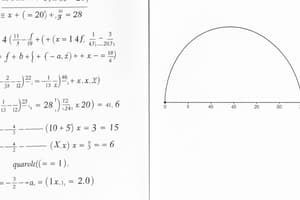Podcast
Questions and Answers
What is a quadratic equation?
What is a quadratic equation?
- A function that has no x values
- A linear function
- A function in standard form is f(x) = ax^2 + bx + c (correct)
- A function that can only have one solution
What is the quadratic term?
What is the quadratic term?
x^2
What is the linear term?
What is the linear term?
x
What is the constant term?
What is the constant term?
If a = 0, then the function has no quadratic term and is not a function.
If a = 0, then the function has no quadratic term and is not a function.
What is a parabola?
What is a parabola?
What does the axis of symmetry refer to?
What does the axis of symmetry refer to?
What do you call the corresponding points mirrored on the other side of the parabola?
What do you call the corresponding points mirrored on the other side of the parabola?
To find the quadratic function to model data, plug into standard form (ax^2 + bx + c = y), solve the system of ____ equations, and write the function.
To find the quadratic function to model data, plug into standard form (ax^2 + bx + c = y), solve the system of ____ equations, and write the function.
What is the British method in factoring?
What is the British method in factoring?
What does the zero product property state?
What does the zero product property state?
What does the quadratic formula state?
What does the quadratic formula state?
If the discriminant is negative, there are two real x-intercepts.
If the discriminant is negative, there are two real x-intercepts.
If the discriminant is positive, there is one real answer.
If the discriminant is positive, there is one real answer.
What is meant by standard form?
What is meant by standard form?
Match the following terms with their definitions:
Match the following terms with their definitions:
Study Notes
Quadratic Equations
- Defined in standard form as f(x) = ax² + bx + c, where a ≠ 0.
- Quadratic term is represented by x²; linear term is represented by x; and constant term is simply a number.
Parabolas and Symmetry
- The graph of a quadratic function is called a parabola.
- The axis of symmetry is a vertical line that passes through the vertex of the parabola, with points mirrored on either side.
Modeling and Factoring
- To model data with a quadratic function: convert to standard form, solve a system of three equations, and write the function.
- Factoring methods include GCF, difference of squares, guess and check, and the British method to find roots.
Special Polynomial Forms
- Perfect square trinomials indicate specific relationships among coefficients: B = (√a) + (√c) x 2.
- Completing the square involves isolating terms, adding squares, and factoring the resulting trinomial.
Solving Quadratic Equations
- Roots can be found through factoring and applying the Zero Product Property: if ab = 0, then a = 0 or b = 0.
- The quadratic formula (x = (-b ± √(b² - 4ac)) / 2a) finds roots directly from any quadratic equation.
Discriminant Analysis
- The discriminant (D = b² - 4ac) indicates the nature of the roots:
- Positive D means two real x-intercepts.
- Negative D means no real x-intercepts.
- Zero D means one real x-intercept, leading to the vertex lying on the x-axis.
Complex Numbers
- Imaginary unit "i" represents √-1; powers of i cycle: i, -1, -i, 1.
- Complex numbers are expressed as a + bi, where a (real part) and b (imaginary part) are real numbers.
Complex Number Operations
- To add or subtract complex numbers, combine corresponding real and imaginary parts.
- For multiplication, use FOIL method; for division, multiply by the conjugate of the denominator.
Absolute Value and Inverses
- The absolute value of a complex number represents its distance from the origin in the complex plane: |a + bi| = √(a² + b²).
- The additive inverse of a complex number is its opposite.
Graphing and Representation
- Complex numbers can be plotted on a plane, with real numbers along the horizontal axis and imaginary numbers along the vertical axis.
- Perfect square trinomials can be easily recognized as factors are identical.
Quadratic Forms
- Standard form: y = ax² + bx + c; vertex calculated as (-b/2a, f[-b/2a]).
- Vertex form: y = a(x - h)² + k; vertex is (h, k), with the axis of symmetry determined by x = h.
Behavior of Parabolas
- If a > 0, the parabola opens upwards and has a minimum point at its vertex.
- The y-intercept can be found by evaluating when x = 0, while x-intercepts are found by solving y = 0.
Studying That Suits You
Use AI to generate personalized quizzes and flashcards to suit your learning preferences.
Description
Test your knowledge on quadratic equations, their standard forms, and the properties of parabolas. This quiz covers modeling, factoring techniques, and methods for solving quadratic equations. Perfect for students looking to strengthen their understanding of this essential mathematical concept.




